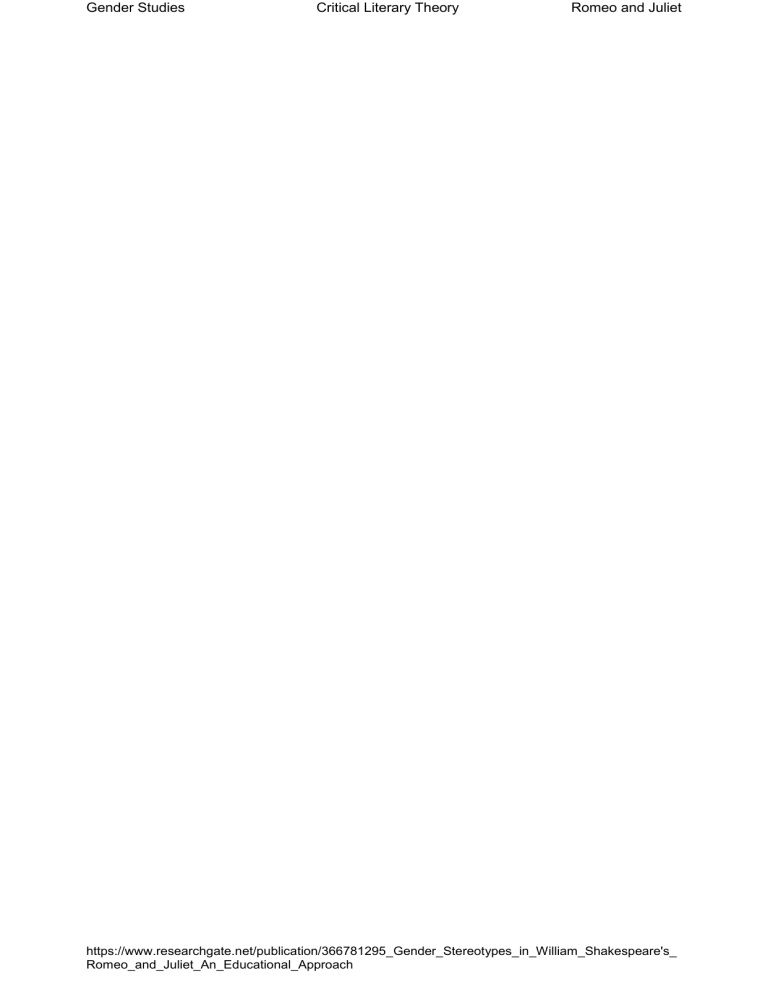
Gender Studies Critical Literary Theory Romeo and Juliet https://www.researchgate.net/publication/366781295_Gender_Stereotypes_in_William_Shakespeare's_ Romeo_and_Juliet_An_Educational_Approach Gender Studies Critical Literary Theory Romeo and Juliet Gender Roles Gender is an important theme within Romeo and Juliet as it contributes to the characters and their development. However, it can still be a source of conflict as the characters do not always adhere to the roles which they are traditionally supposed to fulfil. It is important to note that even though the play is set in a patriarchal society which was oppressive to women, men also had their own social rules that they had to follow. Masculinity and violence The concept of masculinity is a key theme in Romeo Juliet as it dictates the way in which the male characters behave towards each other and the female characters. From the beginning of the play we know there is a feud between the Montagues and Capulets however, the audience doesn’t know the cause of this. Instead, all they are told in the prologue is that it is an “ancient grudge”. No one knows what the feud is about and so it has been manipulated into something based on male pride, with no side willing to back down to create peace. Masculinity and male pride is often associated with destructive behaviour, as shown in Act 1 Scene 1. The fact Shakespeare positions this scene as the opening one is a structural tactic to show how male conflict and violence pervades the play. It also presents to the audience the calibre of the feud and the lengths that Men had a similar entrapment to women as they had to adhere to the attitudes of machismo (hyper sense of masculinity) While women seem to be controlled by the whims and desire of their male counterparts; men seem to be controlled by the very concept of masculinity. men will go to defend their pride. An argument begins between men from each household. As neither side are prepared to lose face and back down a fight starts. ➔ Abraham asks “Do you bite your thumb at me, sir ?” The simple question leads into a fight. ➔ This fight is escalated by the “fiery Tybalt” who exclaims he “hates” the word peace, “Hell” and the “Montagues”. In essence, the men would rather fight than be perceived as cowards. https://www.researchgate.net/publication/366781295_Gender_Stereotypes_in_William_Shakespeare's_ Romeo_and_Juliet_An_Educational_Approach Gender Studies Critical Literary Theory Romeo and Juliet Hegemonic masculinity In the first scene, the character of Sampson is a tool by Shakespeare to express the traditional beliefs of masculinity. Sampson believes in what some call hegemonic masculinity which is the idea that male dominance is established through the submission of women as well as the excursion of their aggression. ● Sampson (a Capulet) argues that “women, being the weaker vessels, are ever thrust to the wall: therefore I will push Montague’s men from the wall, and thrust his maids to the wall”. https://www.researchgate.net/publication/366781295_Gender_Stereotypes_in_William_Shakespeare's_ Romeo_and_Juliet_An_Educational_Approach Gender Studies Critical Literary Theory Romeo and Juliet This belief encapsulates what it was to be a man in Elizabethan times. It is filled with violence and aggression as well as the submission of women. Similar to the way that no one knows what the “ancient grudge” is about and so it has been degraded to just male pride, the concept of masculinity which was once about honour is compromised and is just a show of violence and aggression. The extreme reality of the social construct is directly shown through the family feud between the Capulets and the Montagues. Tybalt is depicted as a calous aggressor powered by his hatered of the Montagues. Conversley, Romeo represents the opposite as he is an effeminate man driven by poetry and romance. In contrast, Tybalt plays the role of a stereotypical male of his time. Shakespeare shows that masculinity reflects all males in a particular society and that it is displayed differently depending on social construcy Romeo’s masculinity It is important to know that throughout the arc of the play the audience never gets to see Romeo’s natural disposition. The audience only sees him when he is suffering from being lovesick over his infatuation with Rosaline or when he is madly in love with Juliet. In some ways, Romeo has no identity free of emotional attachments and could therefore be considered an effeminate character. Act 1 Scene 1 Through Act 1 Scene 1 Shakespeare presents the typical traits of masculinity (strength, power and aggression) through the male characters within the fight. This hypermasculinity is exemplified by the behaviour and language used by Tybalt and Sampson. This masculinity is immediately juxtaposed by Shakespeare’s portrayal of Romeo. Shakespeare feminises Romeo and therefore subverts the masculinity created in the opening scene. ➔ He is described as having “tears” and “adding to clouds more clouds with his deep sighs”. The image created is not one of a hegemonic man but instead of a wounded soul, a courtly lover suffering from unrequited love from Rosaline. https://www.researchgate.net/publication/366781295_Gender_Stereotypes_in_William_Shakespeare's_ Romeo_and_Juliet_An_Educational_Approach Gender Studies Critical Literary Theory Romeo and Juliet Instead of engaging with a battle as his family did in the opening scene, Romeo takes an early morning walk “underneath the grove of sycamore”. ➔ While this image was not that of a traditional Elizabethan male, the image is not foreign to the audience as Romeo is acting like a Petrarchan lover. Petrarchan Lover A petrarchan lover is a man who is suffering from unrequited love. Unrequited love is when love isn’t reciprocated (you love someone and they don’t feel the same way - much like being put in the ‘friend zone’). Petrarchan lovers were often melodramatic about their rejection and would go into a state of depression whereby they could not eat or sleep. ➔ Shakespeare implies that Romeo is in this state as he “away from light steals home” which shows the audience that he stayed up all night and only went home as the sun was rising. https://www.researchgate.net/publication/366781295_Gender_Stereotypes_in_William_Shakespeare's_ Romeo_and_Juliet_An_Educational_Approach


